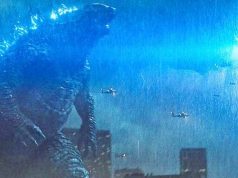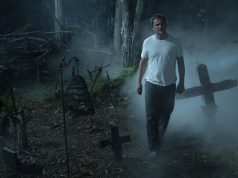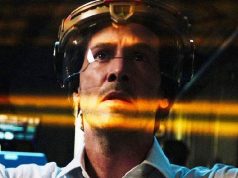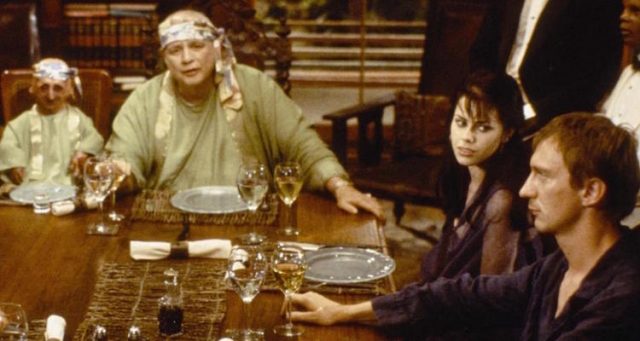
“The Island of Dr. Moreau” begins with three men adrift on a life raft, dying of thirst. Two of them fight, stab each other, and fall into the ocean, where they continue fighting until a shark arrives and eats one of them. The other man resurfaces and tries to climb aboard the raft again, but the remaining occupant hits him in the face with an oar and he drowns.
It is astonishing to think that a movie could start with an underwater knife fight and a shark attack and STILL turn out awful. That never would have happened in the Golden Age of Hollywood. In those days, a talented filmmaker like John Ford or Frank Capra could begin a movie with an underwater knife fight and a shark attack, and follow it with a rousing tale of heroes and villains that entertained audiences while commenting on the nature of man. You better believe there’d be a few shots of Betty Grable’s gorgeous gams, too! Yes sir, in the Golden Age, if a movie opened with knives and sharks, it only got BETTER from there!
Not “The Island of Dr. Moreau,” though. Based on an H.G. Wells novel that had already been made into a movie twice, the film was probably doomed the minute the leading roles were assigned to Marlon Brando and Val Kilmer. Both actors were notoriously difficult to work with. (Kilmer has since mellowed out; Brando, however, has only become more intractable since his death.) One or the other could probably have been managed by a highly experienced director, or a child psychologist, or a dog whisperer. But both of them? In the same film? That’s too much. A movie set can only handle one mildly insane, Method-acting diva at a time.
The film’s behind-the-scenes problems are legendary. The director, Richard Stanley, was fired after three days of shooting, replaced with John Frankenheimer, who’d been making movies for 40 years yet somehow had never made one with grotesque animal-human hybrids or Marlon Brando. (But I repeat myself.) The screenplay was almost entirely rewritten while the film was being shot, as Frankenheimer felt Stanley’s original vision wasn’t baffling or incoherent enough. Kilmer and Frankenheimer bickered constantly, and Brando got bored and irritable. To make matters worse, the production was struck with fairuza balk, a tropical disease that affects– No. I’m being told “Fairuza Balk” is a person, and that she played one of the characters in this movie. That seems unlikely, but whatever.
The life-raft survivor is Edward Douglas (David Thewlis), though in H.G. Wells’ book he was called Edward Prendick, and I can’t imagine why they changed it (snicker). Douglas is a U.N. official whose plane crashed in the Java Sea en route to a peace negotiation. After his fellow survivors kill each other (with the assistance of a shark and an oar to the face), Douglas is rescued by a passing supply ship. Onboard is Montgomery (Val Kilmer), a weird doctor who nurses Douglas back to health as the ship returns to its headquarters.
Those headquarters are a tropical island that belongs, as you might have guessed, to one Dr. Moreau, whom we don’t see for a while, in order to build suspense, and to give Brando time to put on his makeup. In the meantime, Montgomery makes his guest comfortable by snapping a rabbit’s neck in front of him, then locking him in a room while saying, in a comically ominous tone, “It’s for your own good.” We wonder what he’s protecting Douglas from. Maybe there’s a smoke monster! Or, if you’d prefer a “Gilligan’s Island” reference over a “Lost” reference, maybe Mrs. Howell is angry because someone stole her jewelry! I hope no one votes him off the island! Ha ha I give up.
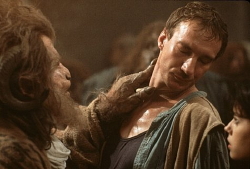
Douglas escapes from his room and goes snooping around, and you can predict what happens next: he stumbles into a rudimentary operating room in which a monster lady is giving birth, attended by a team of subhuman mammalian doctors. Laugh if you want, but THIS IS WHAT AWAITS US UNDER OBAMACARE®!!!1!11!! Douglas, now more alarmed by this kooky island than he already was, flees into the jungle, where he encounters a whole tribe of animal-people. They are friendly to him because he’s a full-on human, which is what they aspire to be, as do we all.
Turns out Dr. Moreau has been fusing human and animal genes together, trying to create an advanced species that has none of mankind’s evil tendencies but all of mankind’s housebroken tendencies. These monstrous aberrations are the result. Most of them are still more animal than human, resembling boars, goats, Danny DeVito, and the like. Dr. Moreau — whom they refer to as “the Father” — has trained them not to kill other living things. They’ve all been implanted with chips so that Moreau can shock them if they misbehave, just like a real father.

At last the good doctor himself arrives on the scene. He does not disappoint. He has the girth of a sumo wrestler and the pasty white coloring of a kabuki performer, the latter from the sunscreen he slathers on his body because he is obsessed with the heat. (Sure, move your ghastly animal-experimenting facility to a tropical island, then complain about the tropical weather.) He wears billowing, tent-like muumuus much like those worn by Homer Simpson in that episode where he got hugely fat — an episode that aired a year before this movie came out, by the way, so it wasn’t a parody. It was a prophecy.

One of many bizarre, extraneous details in this film is that Dr. Moreau is accompanied by a tiny man who dresses and acts like him. He’s named Majai, and he’s played by an actual tiny man who was in the Guinness Book of World Records for being so damn tiny. Moreau’s miniature doppelgänger was the inspiration for Dr. Evil’s Mini-Me, of course, making this the rare film in the Eric’s Bad Movies canon to have produced a positive effect on the world. (Compare that with “Star Trek V,” which caused there to be more “Star Trek” movies, or “Showgirls,” which gave audience members herpes.)
Dr. Moreau’s one successful creation so far is his “daughter,” Aissa, played by the alleged “Fairuza Balk,” whatever that is. We’re not told what kind of animal she used to be, but now she looks pretty much like a normal young lady, the kind that can flirt with Douglas and try to help him escape from this horrible island. Montgomery gives her regular doses of a serum to keep her from regressing back to her animal state; when she stops taking it, her teeth grow into fangs, overnight. Douglas finds the new dental condition off-putting, which is pretty rich, coming from an English guy.
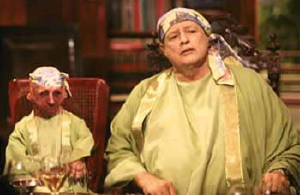
So you’ve got a mad scientist making humanimals, an equally mad assistant throttling bunnies, and a herd of genetic mutants who are mildly resentful of their creator. All that remains in a situation like this is for all hell to break loose. And loose is what all hell most certainly does break! One of the manimals figures out how to remove his implant — well, he rips it out of his chest with his bare hands; I don’t know how much “figuring” was involved — so Moreau can’t give him electric shocks anymore. Once that secret is out, and once they learn how to use weapons, forget about it. The movie wants us to reflect soberly on the fact that these once-harmless animals have become “men,” i.e., they have guns and self-esteem issues.
Not to spoil anything, but this is the kind of movie where pretty much everyone except the main character dies. Unfortunately, the main character is Edward Douglas, who is boring, especially compared to the lunatics played by Brando and Kilmer. Say what you will about those actors, they certainly keep things lively, Kilmer with his occasional impersonations of Brando (he really does that), Brando with his wearing a hat full of ice on his head (he really does that). I was rather sad when some beastmen tore Dr. Moreau limb from limb, and when they shot Montgomery. Characters that nutty deserve to live. That’s why Courtney Love and Tyra Banks are still around.
But if you’re in the mood for a movie that contains a lot of grunting and squealing, and a lot of extras wearing animal costumes, and a disturbingly tiny man imitating one of the greatest actors of the 20th century, then “The Island of Dr. Moreau” will certainly meet those needs. If you’re in the mood for an underwater knife fight and a shark attack, it will also meet those needs, albeit only briefly.
— Film.com


